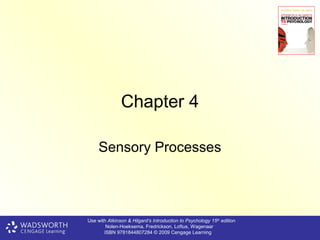
Lecture2:Chapter 4 Sensation - Dr.Naif AlMutawa
- 1. Chapter 4 Sensory Processes Use with Atkinson & Hilgard’s Introduction to Psychology 15th edition Nolen-Hoeksema, Fredrickson, Loftus, Wagenaar ISBN 9781844807284 © 2009 Cengage Learning
- 2. Sensory Processes • Senses: – Include vision, hearing, smell, taste, and touch (which includes pressure, temperature and pain) • Sensation – At psychological level, sensations are raw experiences of stimuli not yet imbued with meaning Use with Atkinson & Hilgard’s Introduction to Psychology 15th edition Nolen-Hoeksema, Fredrickson, Loftus, Wagenaar ISBN 9781844807284 © 2009 Cengage Learning
- 3. Characteristics of Sensory Modalities • Sensory system – Task of acquiring information from environment and transducing it into neural representation in brain • Threshold sensitivity – Absolute thresholds: detecting minimum intensities • The absolute threshold is the minimum amount of stimulus which reliably registers on sensory organ • Values determined using psychophysical procedures – measure relation between physical magnitude of some stimulus (e.g. the physical intensity of the light) and psychological response (how bright the light appears to be). It’s the value the stimulus at which it is detected 50% of time. Use with Atkinson & Hilgard’s Introduction to Psychology 15th edition Nolen-Hoeksema, Fredrickson, Loftus, Wagenaar ISBN 9781844807284 © 2009 Cengage Learning
- 4. Psychophysical procedures In one commonly used technique, the experimenter first selects a set of stimuli whose magnitudes vary around the threshold. Over a series of what are called trials, the stimuli are presented one at a time in a random order and the observer is instructed to say yes if the stimuli is present and no if it is not. Each stimulus is presented many times for a percentage of yes. Use with Atkinson & Hilgard’s Introduction to Psychology 15th edition Nolen-Hoeksema, Fredrickson, Loftus, Wagenaar ISBN 9781844807284 © 2009 Cengage Learning
- 5. Characteristics of Sensory Modalities • ...Threshold sensitivity – Difference thresholds: detecting change in intensity • Difference threshold is the minimum difference between two stimuli which can be reliably distinguished by sensory organ • Another term is the JND or the Just Noticeable Difference • In a typical change detection study, observers are presented with a pair of stimuli. One is the standard that all is compared to. The other is called a comparison stimuli. The observers are asked to respond with “more” or “less” than the standard. Use with Atkinson & Hilgard’s Introduction to Psychology 15th edition Nolen-Hoeksema, Fredrickson, Loftus, Wagenaar ISBN 9781844807284 © 2009 Cengage Learning
- 6. Characteristics of Sensory Modalities • ...Threshold sensitivity – Heinrich Weber and Gustav Fechner found that the larger the value of the standard stimulus, the less sensitive the sensory system is to changes in intensity. In fact, the intensity by which the standard must be increased is proportional to the intensity of the standard. Use with Atkinson & Hilgard’s Introduction to Psychology 15th edition Nolen-Hoeksema, Fredrickson, Loftus, Wagenaar ISBN 9781844807284 © 2009 Cengage Learning
- 7. Characteristics of Sensory Modalities • Signal detection theory – Information consists of signals and noise where “signal” refers to important aspect of information and “noise” refers to unimportant aspect of information Use with Atkinson & Hilgard’s Introduction to Psychology 15th edition Nolen-Hoeksema, Fredrickson, Loftus, Wagenaar ISBN 9781844807284 © 2009 Cengage Learning
- 8. Characteristics of Sensory Modalities • ...Signal detection theory – Hits and false alarms • False alarm – signal falsely detected where there is only noise • Hit – signal correctly detected • Sensitivity of sensory organ indicated by differences in hits and false alarms – Sensitivity and bias • Useful characteristic of signal detection analysis – allows process of detecting stimulus to be separated into two numbers – one representing sensitivity to signal and one representing bias in stating “signal present” Use with Atkinson & Hilgard’s Introduction to Psychology 15th edition Nolen-Hoeksema, Fredrickson, Loftus, Wagenaar ISBN 9781844807284 © 2009 Cengage Learning
- 9. Characteristics of Sensory Modalities • Sensory coding – Two fundamental issues for sensory systems • How to translate incoming physical information and how to encode aspects of physical information to corresponding neural representation • Specialized cells called receptors (specialized neurons) detect stimulus (are activated) and pass an electrical signal to connecting neurons through to cortex where the electrical signal results in conscious sensory experience Use with Atkinson & Hilgard’s Introduction to Psychology 15th edition Nolen-Hoeksema, Fredrickson, Loftus, Wagenaar ISBN 9781844807284 © 2009 Cengage Learning
- 10. Characteristics of Sensory Modalities • ...Sensory coding – Coding of intensity and quality • Useful sensory information includes intensity and quality of stimulus • Primary means for coding intensity of stimulus is via the rate of neural impulses – greater intensity, greater firing rate and greater firing rate, greater perceived magnitude of stimulus • Coding quality is more complex. It is generally agreed that the brain codes qualitative differences between sensory modalities according to the specific neural pathways involved. Sensory system may also use a pattern of neural firing to code quality of sensation Use with Atkinson & Hilgard’s Introduction to Psychology 15th edition Nolen-Hoeksema, Fredrickson, Loftus, Wagenaar ISBN 9781844807284 © 2009 Cengage Learning